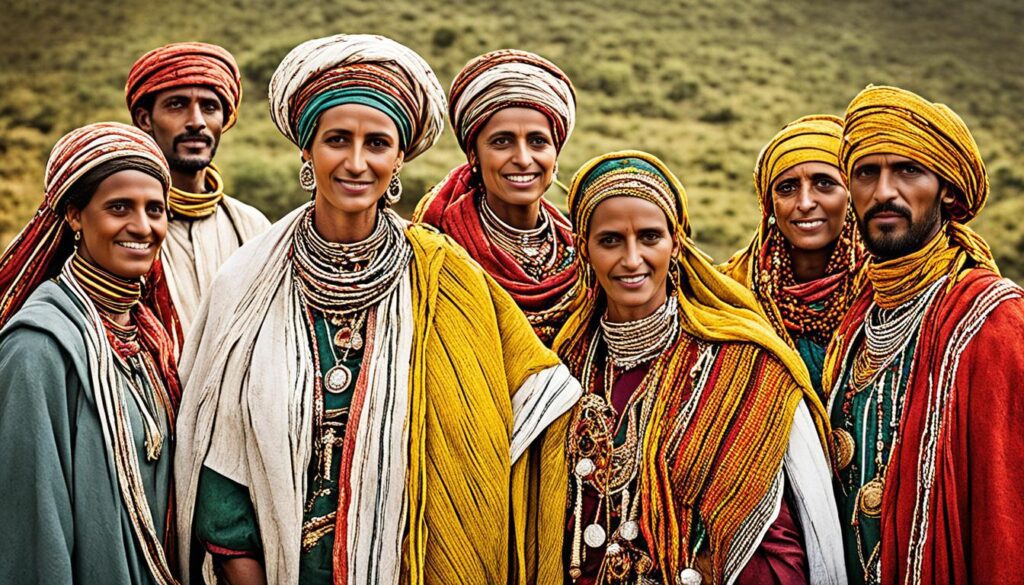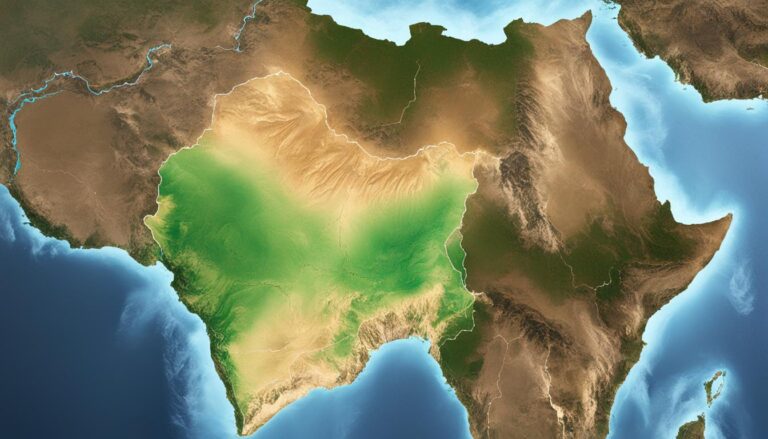How Large Is Ethiopia?
When it comes to size, Ethiopia is an African giant. Spanning an impressive land area of approximately 1,112,000 square kilometers (429,000 square miles), this East African nation is not only vast but diverse in its topography and cultural heritage. From the towering peaks of the Abyssinian highlands to the Rift Valley Lakes and sprawling grasslands, Ethiopia’s geographical expanse is as captivating as it is extensive.
Key Takeaways
- Ethiopia covers a land area of approximately 1,112,000 square kilometers (429,000 square miles).
- It is the 10th largest country in Africa and larger than France and Spain combined.
- Ethiopia’s topography includes the awe-inspiring Abyssinian highlands, Rift Valley Lakes, and vast grasslands.
- With over 80 ethnic groups and more than 80 languages spoken, Ethiopia is a culturally diverse nation.
- As one of the oldest independent countries in Africa, Ethiopia has a rich and ancient history that continues to shape its identity today.
Ethiopia’s Geographic Position and Borders
Ethiopia, located in the Horn of Africa, occupies a strategic geographic position. It shares its borders with several neighboring countries, enhancing its regional connectivity and trade potential.
To the north, Ethiopia is bordered by Eritrea, with which it shares a historically complex relationship. The two countries have had border disputes in the past, resulting in the Eritrean War of Independence and subsequent conflicts.
In the northeast, Ethiopia’s border meets Djibouti, a small country known for its port on the Red Sea. This proximity to Djibouti provides Ethiopia with easy access to international trade routes.
To the east and southeast, Ethiopia’s borders extend towards Somalia. This border is marked by the Ogaden region, an area with a predominantly Somali population. The countries share cultural ties and face common challenges in terms of security and political stability.
Heading south, Ethiopia shares a border with Kenya. This border enhances regional economic integration and facilitates cross-border trade, contributing to the socio-economic development of both countries.
To the west, Ethiopia shares its border with South Sudan. The two countries have historically enjoyed friendly relations, with South Sudan gaining independence from Sudan in 2011. This border creates opportunities for cooperation and collaboration in areas such as trade, security, and regional stability.
Finally, Ethiopia’s northwest border is shared with Sudan. This border has shaped historical and cultural exchanges between the two countries, as well as economic ties, particularly in the areas of trade and agriculture.
Despite its strategic location, it is important to note that Ethiopia is landlocked. The former Ethiopian territory of Eritrea gained independence in 1993, leaving Ethiopia without direct access to the coastline. However, the country’s geographic position still plays a crucial role in facilitating its international trade and diplomatic relations.
The Size and Topography of Ethiopia
Ethiopia, the 10th largest country in Africa, boasts a land area roughly equivalent to France and Spain combined. Spanning vast dimensions, both north-south and east-west, Ethiopia’s size contributes to its significant presence on the African continent.
One of the defining characteristics of Ethiopia’s landscape is its diverse topography. The northern and central regions are dominated by the impressive Abyssinian highlands, home to towering mountains exceeding 4,000 meters (13,200 feet) in height. This rugged terrain creates a breathtaking backdrop and showcases the country’s extraordinary natural beauty.
To the west of the highlands, the land gradually descends, giving way to the grasslands of Sudan. On the eastern side lies the deserts of the Afar, adding to the remarkable variation in Ethiopia’s topography. In the south, the Rift Valley Lakes define the landscape, complete with stunning vistas and abundant wildlife.
This diversity in topography not only contributes to Ethiopia’s scenic allure but also plays a significant role in shaping the country’s climate, ecosystems, and agricultural practices. It showcases the remarkable natural wonders that Ethiopia has to offer.
Ethnic Diversity and Population of Ethiopia

Ethiopia is a melting pot of diverse ethnic groups, with over 80 different communities contributing to the rich tapestry of the country’s cultural heritage. These ethnic groups form an intrinsic part of Ethiopia’s identity and population dynamics.
The largest ethnic groups in Ethiopia are the Oromo and the Amhara, accounting for approximately 60% of the total population. The Oromo people are the largest ethnic group, mainly inhabiting the central and western regions of the country. The Amhara people, on the other hand, are concentrated in the northern and central highlands of Ethiopia.
While the Oromo and Amhara are the most populous ethnic groups, Ethiopia is also home to several other significant communities. These include the Somali, Tigrayan, Sidama, Gurage, Welayta, Hadiya, Afar, and Gamo ethnic groups, among others. Each group contributes its distinct traditions, languages, and cultural practices to the vibrant mosaic of Ethiopian society.
| Ethnic Group | Percentage of Population |
|---|---|
| Oromo | 34.4% |
| Amhara | 27% |
| Somali | 6.2% |
| Tigrayan | 6.1% |
| Sidama | 4% |
| Gurage | 2.5% |
| Welayta | 2.3% |
| Hadiya | 1.7% |
| Afar | 1.7% |
| Gamo | 1.5% |
The diverse ethnic composition of Ethiopia is reflected in its population, which stands at approximately 128 million people. It’s worth noting that about 85% of the population resides in rural areas, while the remaining 15% live in urban centers. With a high population growth rate of about 3.09%, Ethiopia is experiencing rapid demographic changes.
The multicultural nature of Ethiopia contributes to its unique societal fabric, fostering an environment of mutual respect and coexistence. The country embraces its diversity, which is celebrated through cultural festivals, traditional practices, and linguistic heritage. This profound ethnic tapestry forms the foundation for Ethiopia’s vibrant and dynamic society.
Language Diversity in Ethiopia

Ethiopia is renowned for the remarkable linguistic diversity that permeates the country. With an astounding array of over 80 languages and more than 200 dialects spoken throughout its vast expanse, Ethiopia stands as a testament to the rich tapestry of cultures and traditions that flourish within its borders.
The official language of Ethiopia is Amharic, which serves as a unifying force among the diverse ethnic groups. Amharic holds significant importance in government affairs, education, media, and business transactions. It is estimated that around 32% of the population speaks this language.
However, the Ethiopian government recognizes and values the importance of preserving and promoting local languages. In an effort to foster cultural diversity and inclusivity, the government encourages the teaching and use of local languages in schools and various public institutions alongside Amharic.
Some major languages spoken in Ethiopia apart from Amharic include:
- Oromigna: Spoken by the Oromo ethnic group, Oromigna is the most widely spoken language in Ethiopia. Over a third of the population speaks this language, making it an essential part of the country’s linguistic landscape.
- Tigrigna: Primarily spoken by the Tigray ethnic group, Tigrigna holds significant importance in the northern part of the country. It is estimated that around 8% of the population speaks Tigrigna.
The linguistic diversity in Ethiopia not only reflects the cultural richness but also serves as a bridge connecting the various communities that call Ethiopia home. Each language carries with it a wealth of stories, traditions, and distinct worldviews, contributing to the vibrant mosaic of Ethiopian society.
Language Diversity in Ethiopia – Quick Facts:
| Language | Percentage of Population |
|---|---|
| Amharic | 32% |
| Oromigna | 34% |
| Tigrigna | 8% |
| Other Languages | 26% |
“Language is the road map of a culture. It tells you where its people come from and where they are going.” – Rita Mae Brown
Ethiopia’s Historical Significance and Influence
Ethiopia boasts a rich and ancient history that spans thousands of years. As one of the oldest independent countries in Africa, it holds a remarkable legacy steeped in captivating narratives and profound cultural contributions. With over 3,000 years of history, Ethiopia stands as a testament to endurance, resilience, and enduring traditions that have shaped its unique identity.
In ancient times, Ethiopia was recognized for its prosperous civilizations. The Kingdom of Aksum, for instance, thrived for an astonishing 900 years. This empire left an indelible mark on Ethiopia’s historical landscape through its sophisticated trade networks and cultural achievements. Notably, the Kingdom of Aksum was among the first civilizations to embrace Christianity, adopting it as the state religion in the 4th century, a landmark event that continues to shape Ethiopian society to this day.
Ethiopia’s historical significance extends beyond its borders, with the country playing a pivotal role in global affairs. A remarkable testament to Ethiopia’s resilience and independence is its victory in the Battle of Adwa in 1896. This triumph against colonial Italy, whose forces sought to establish dominance over Ethiopia, firmly asserted Ethiopia’s sovereignty and served as an inspiration to other oppressed nations striving for independence.
The Battle of Adwa, where Ethiopia valiantly defended its freedom, is a testament to the unwavering spirit and determination that continues to define the country’s historical narrative.
Throughout its history, Ethiopia has maintained its independence, fending off external threats and preserving its cultural heritage. This resilience has shaped Ethiopia into a nation whose history and cultural influences resonate far and wide. Today, Ethiopia stands as a beacon of African independence, commanding respect and admiration from across the globe.
By embracing its past and celebrating its accomplishments, Ethiopia continues to forge its path forward, drawing strength from the lessons of its history. Ethiopia’s historical significance and influence serve as a constant reminder of the power of culture, courage, and unity.
| Historical Achievement | Impact |
|---|---|
| Kingdom of Aksum’s Dominance | Established trade networks, embraced Christianity, influenced neighboring regions. |
| Battle of Adwa | Symbol of African resistance against European colonialism, inspired the struggle for independence in other countries. |
Conclusion
Ethiopia’s vast land area and diverse geography contribute to its significance as an African nation. With a population exceeding 128 million, Ethiopia plays a major role in regional and global affairs. Its size and strategic location, with borders touching multiple countries, give it geopolitical importance.
But it’s not just the physical dimensions that make Ethiopia important. The country’s rich history, spanning over 3,000 years, has shaped its cultural identity and historical significance. From ancient civilizations to the victory against colonial Italy in the Battle of Adwa, Ethiopia’s resilience and independence have left an indelible mark.
Furthermore, Ethiopia’s ethnic diversity and linguistic richness create a tapestry of cultures that contribute to its vibrancy. With over 80 different ethnic groups and a wide array of languages spoken, Ethiopia’s cultural heritage is truly remarkable.
As Ethiopia continues to face various challenges and work towards development, it remains an influential and prominent nation in Africa. Its significance extends beyond its size and borders, encompassing its contributions to history, culture, and regional dynamics. Ethiopia’s importance on the African continent cannot be overstated.





